ZERO to HERO
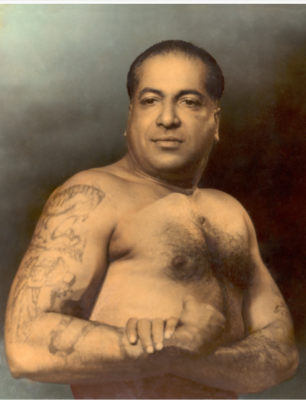
The Remarkable Story of Rudra the Weakling
who became the Strongest Man in the East!
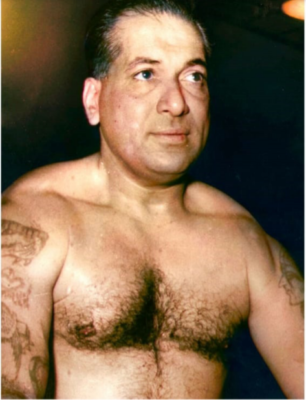
Rudra the weakling who became the strongest man in the East
with immense self-will, grit, determination and perseverance!
POWER OF GRIT AND DETERMINATION
A two and a half year-old child ran along the railway track and was knocked down by a train. The cow-catcher caught him on the skull and threw him clear off the track.
This child was one in a million. He survived the serious injury to his skull, but afterwards was left so frail and weak, subject to giddiness, voice failure and breathing difficulties that he was excused from physical exercises at his school.
It was the constant teasing, taunting and the jeers of schoolmasters that metamorphosed and transformed Rudra from a thin, weak, sickly boy to a strong man.
And this weakling with the passing of years, by grit, selfdetermination and perseverance turned out to be the STRONGEST
MAN IN THE EAST!
This Is The Remarkable Story Of Thillainathan Rudra. A Miracle Child, Who From Humble Beginnings Went On To Become The Strongest Man In The East And A Charismatic Mayor Of Colombo!
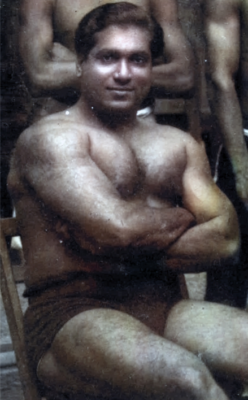
EARLY YEARS
Thillainathan Rudra was born on 04 August 1908 in Vattukkottai, a small but important town in the minority Tamil dominated Jaffna peninsula of Sri Lanka (formerly Ceylon).
He was the only son born to Mr. and Mrs. Thillainathan. He had two sisters, one older and the other younger.
In his early days he was considered a real weakling. He survived a serious head injury from a train accident as a child aged two. This left him quite frail, thin, weak, and sickly. He was constantly subject to giddiness, voice failure and breathing difficulties that he had to be excused from physical exercises at his school.
While recounting those early days, Rudra in conversation, used to tell his friends:
“Feel this” and point at his forehead. A steel plate reinforced his skull.
His teachers in Jaffna College considered Rudra too weak to participate in any games. He was not only forbidden to play any sport, but even to stand on the sideline at soccer matches in case he was knocked over by the ball!
His teachers were specially requested not to speak harshly or to inflict corporal
punishment.
The constant teasing, jeering, mocking, bullying, and taunting that he was subjected to in his early years made him determined to become strong. “It was slighting! This insulting and snubbing was the one thing that constantly worked in my mind. I was determined to become a strong man!”
But the young boy had no scope to realise this ambition until he left for Malaysia. His interest in bodybuilding and sports began late in his teens after his father took him to Malaysia. In 1925 at the age of 16, having joined his father who was an employee in the Malayan Railways, he saw a gym for the first time.
The Railway Institute had some gymnastics apparatus. The youthful aspirant seeing his chance to become strong, read books on physical culture and drew up his own course for body building.
REMARKABLE TRANSFORMATION
Determined to overcome his early handicap Rudra took to Athletics at the age
of 16, specializing in the 440 yards , half mile and mile. He won trophies in these events at school meets at St John’s Institution, Kuala Lumpur, Malaysia, and events organized by the Tamilian Physical Culture Association & the Railway Institute.
At the age of 18 he took to boxing and won the feather weight title of Selangor State, Malaysia.
He also took like a duck to water in Gymnastics, Judo and Ju Jitsu. He went to Japan
with a Japanese businessman to perfect his Judo.
He returned to Jaffna in 1927 when his father passed away. As there was no gym facilities available in Jaffna he continued training in his backyard using primitive home-built weights made of concrete.
“I learned that most of the world’s strongest men had been weaklings in their youth. So I had hope. For two years I coached myself and took intensive indoor exercises so that when I returned to Jaffna as an 18 year old in 1927 my teachers and friends found that I had changed completely. I began to enjoy the reputation as a powerfully built boy.”
Along with body building he also practiced Raja Yoga. Soon he developed not only ‘body beautiful’ but immense strength.
Before the age of 21, considered a minor in those days, Rudra had an elephant stand on his chest, for the first time, when he voluntarily performed this amazing feat to a Russian circus that came to Jaffna.
It is understood that a close friend, who was also under the legal age, signed the consent form secretively without the knowledge of Rudra’s mother. This permitted Rudra to perform this extremely dangerous feat. His friend described that he broke into cold sweat as Rudra took the full weight of the elephant… but Rudra’s strength held!
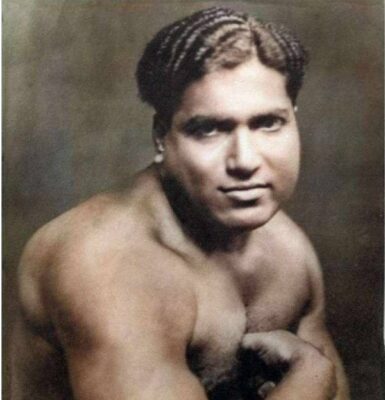
eaRlieST phoTo of RudRa in hiS youTh
CHILD’S PLAY
‘I have seen Mr. Rudra flexing his muscles at the Central YMCA Gymnasium where he is the chairman of the YMCA Physical Cultural Department. He lifts weights with as much ease as you would lift a cricket ball’ – Sunday Times of Ceylon 11th October 1953.
Rudra expanded his display of dynamic physical strength performing a variety of remarkable feats that thrilled many. For someone who less than a decade ago, could hardly engage in sport, he was now exhibiting the most incredible and dangerous exploits that became mere child’s play to him.
Some of these achievements were:
- Having a motor car driven over
- Taking the bare wheel of a double-bullock cart loaded with 20 men over his (This difficult feat was performed only once at the Jaffna Esplanade in 1932).
- Getting huge boulders rolled over his chest by 20 to 30
- Snapping iron chains and bending iron
- De-husking coconuts with his bare
- Having an iron rod hammered out on an anvil (heavy block of steel iron)
placed on his chest while he lay on a bed of poisonous nails.
- Being buried
- Having elephants stand on his chest
‘A specialty of Mr. Rudra was to lie on a bed of nails with a rock about half a ton in weight placed on his chest. Once an inch thick rod of mild steel was cut on an iron slab placed on his chest while he lay in that posture.’ – Sunday Times of Ceylon 11th October 1953
YODAYA (GIANT)
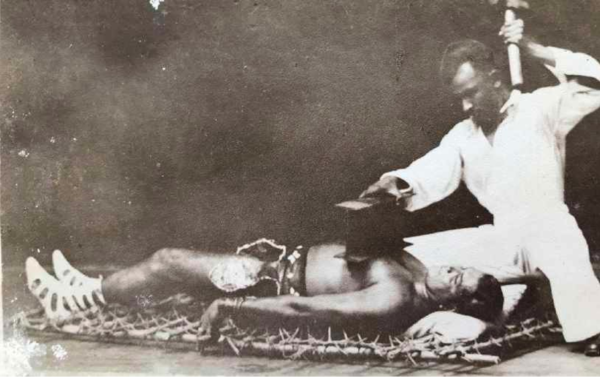
‘Rudra was the type of man you usually come across in adventure stories or serial films – a giant who could balance a seven-foot high elephant on his chest or rout a hostile mob single handed. “I was once twice this size”, he told me. That was in the early 1930’s when Mr. Rudra was Ceylon’s strongest man.’ – Sunday Times of Ceylon 11th October 1953
Rapidly Rudra became so famous for his feats of strength that wherever he went
word spread the ‘Yodaya’ (Giant) had come and people flocked to see him.
School masters and school mistresses complained that it was difficult to have good attendances whenever the ‘Yodaya’ was expected to pass by the school. The boys especially would keep away from school to enjoy the thrill of seeing Rudra.
ELEPHANT ON HIS CHEST
Rudra would lie prostrate to balance a seven-foot high elephant on a block of wood placed on his chest, abdomen, and thighs. The entire weight of the elephant was transferred on to his body for about a minute.
He performed this feat about a hundred times in Ceylon, Burma (Myanmar), India, Siam, Malaysia, Indonesia and with the Layton Russian Circus, Izako Russian Circus and Carlton American Circus.
While performing this feat he put his life on the line on several occasions. “Sometimes the elephant balanced itself and refused to budge.” But Mr. Rudra’s strength held. He was able to bear the weight for more than a minute until the mahout could get the elephant under control.
BURIED ALIVE
Buried alive in a bare pit 6 feet deep, 7 feet in length and 3 feet wide was a feat no other person had attempted in Ceylon. Rudra was lowered into a normal size grave with only his clothes on and covered with earth. Others who performed this stunt were usually buried in a coffin.
Rudra usually performed this feat at midnight. His diet for the day of his performance was only fruit juice and glucose. His wager to stay buried for six hours (midnight to 6 am) went unaccepted.
The longest period he remained buried in this manner was an hour and twenty minutes in 1932.
On his ‘Buried Alive’ feat Rudra said, “I would have gone on longer if not for some petrified spectators that had me dug out, even though I did not signal for the rescue.”
According to him the first minute was the toughest, the second minute a bit tough and the third minute it got easier. Thereafter the feat was simple!
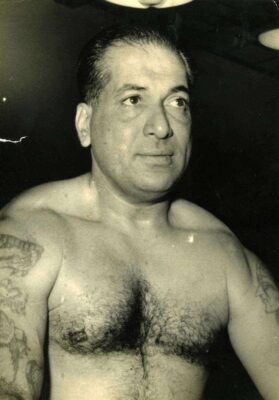
STRONGEST MAN IN THE EAST
“Some of his feats are World Records” – The Ceylon Observer, Sports Supplement 14 Feb 1958
Rudra toured Ceylon and India and performed feats of muscular power and strength – the money earned being donated to various charities. The years 1932- 33-34 (age 24 to 26) saw him at the height of his powers. He performed in many carnivals in Colombo.
In 1932, at the Jaffna Esplanade, he had a bare wheel of a double bullock cart
loaded with twenty men driven over his neck.
At the ‘Harbour Lights Carnival’ for a whole month he gave a display in which an
elephant was allowed to stand on his chest.
In 1947, aged of 39, at the ‘Colombo Calling Carnival’ he astounded a mammoth gathering by successfully withstanding for a few minutes an attempt at strangulation by twelve men, six on either side tugging at a rope passed around his neck.
On one occasion Rudra balanced two elephants on his chest at the Patiala Palace, India in the presence of the Maharajah of Kashmir & Patiala.
With grit, self-determination and great perseverance this ‘weakling’ turned out to become the ‘Strongest Man in the East’.
“No one has a better right to appraise the Physical Culture of Prof. Rudra. We grew up together, and as a boy he was the object of derision and pity to his schoolfellows.
Today he is a Sandow of international reputation. His feats of strength and audacity fill us all with amazement. I cannot explain his wonderful and prodigious development short of Genius to unfold the power and potency of the human body! I have watched him from his tentative endeavours to the perfect art of his greatest performances, with an ever-deepening sense of admiration. Who could have dreamt that the lean and sickly boy of ten years ago, should today be the Admired of all Admirers?” – T Navaratnarajah, Reference to Prof. T Rudra’s book on Dynamic Strength.


DYNAMIC STRENGTH
Prof. Rudra wrote a book titled ‘Dynamic Strength’ to express that physical exercise is an essential part of mental and psychological well-being.
In its forward he wrote “In Plato’s curriculum of education in the Republic, physical training occupies a prominent place. We men of Today cannot afford to set aside the Greek and Roman ideal of ‘Mens Sana in Corporo Sano’ (translated as ‘Healthy Mind in a Healthy Body’)”. The decadence or dissipation of today’s manhood is a sad and pitiable spectacle. Let the manhood of Ceylon awake, arise to the ancient and Bliss giving conception of Health and Strength. The poetry of the human body is a secret that can be taught and learnt. There is no happiness outside of Health and Strength. Partake of this joy from me. The way and the guide for the manifold blessings of physical well-being. My System of Dynamic Strength will make a He- man of you!”
HEYDAY PHYSIQUE & DIET
In his heyday at the age of twenty five Rudra sported a chest of 47 inches (120 cm) and weighed 270 pounds (122.5 kg) stripped.
His daytime meal comprised of 20 eggs, 8 bottles milk, 1 lb. almonds, honey, 10 to 12 country flour string hoppers, ¼ lb. ghee (in meals), 1 lb. liver, one whole chicken and vegetables.
His dinner was mainly concentrated soup of two whole chickens or 4 lbs. of mutton and chapatti.
SUMMARY JUSTICE
In 1938 when Rudra was on his way to the Magistrate’s Court to give evidence for the Police in an assault case where he was the informant, he was attacked by a bunch of thugs with bottles, stones, and knives. Before he was stabbed, he floored six of them unconscious while the rest fled. Nineteen days after he received a 3 ½ inch stab injury in his chest he gave a display of strength at the Regal Theatre.
LAW & ORDER
Mr. Rudra also came into prominence at the age of 33 when he was called upon to stop the looting and to restore law and order after the Japanese air raid of Colombo in April 1942.
During the 1958 ethnic riots, when mobs were looting and burning houses and killing members of the minority Tamil Community, Rudra single-handedly patrolled his street and neighbourhood. Not one incident was recorded in the vicinity.
POLITICS
When the Municipal Elections were held in 1946, Mr. Rudra was elected Member for Wellawatte South Ward (Colombo) after defeating a prominent candidate Dr.
E.A. Coorey, who had been the sitting member for twenty three years.
Throughout this period he made immense contributions to this ward and remained a councillor until his untimely death in 1960.
EXPERT LEGAL SKILLS
On one occasion a corruption case was brought against some municipality staff. Dr. Spittel a well-known scholar and one-time head of the Ceylon Medical
Association wrote a tribute praising Mr. Rudra. “Although not a lawyer Mr. Rudra displayed expert legal skills, taking up the case single handed and winning it against prominent lawyers.”
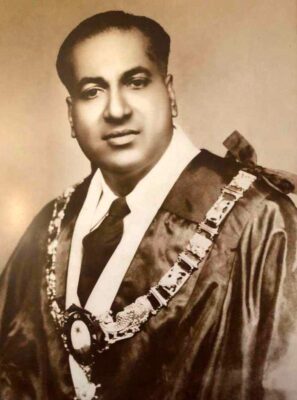
‘COLOMBO’S MAYOR – MAN WITH
A PUNCH’
“He carried an Elephant on his Chest – can he now carry the City on his Shoulders?” – Sunday Times of Ceylon
As a tribute to his stamina, integrity, honesty, resourcefulness, and leadership qualities Mr. Rudra was chosen to the exalted position as the Mayor of Colombo in 1953.
‘Now that he is Colombo’s first citizen, will Mr. Rudra’s shoulders prove strong enough to bear the burden of Municipal administration. Can he pack enough punch that will or should clean the Town Hall of corruption and inefficiency, and wrestle with the problems of municipal politics?’ – Sunday Times of Ceylon 11th October 1953.
Rudra’s illustrious career had many highlights. The crowning moment was when he (and Mrs. Rudra) received Queen Elizabeth and her husband Prince Phillip on the Queen’s Commonwealth Coronation Tour.
‘SIR THILLAINATHAN RUDRA’ he may well have been. In April 1954 he had the privilege of being knighted by Her Majesty the Queen Elizabeth II in person if he accepted the honour – but he decided otherwise; his sense of humility was too great.
In that year of office as the First Citizen of Colombo he had to make a courageous decision to receive the Queen, because the Left-Wing groups in the Council who had elected him were not in favour of a civic reception to Her Majesty.
Despite much opposition Mr. Rudra decided it would be in the best interest of the common ratepayer of the City to be present at the only function to which they were to be invited during the entire visit of the Queen to Ceylon.
The function was one of the most colourful events in the history of the Council and was a grand success mainly because it enabled thousands of poor ratepayers in the City to participate.’
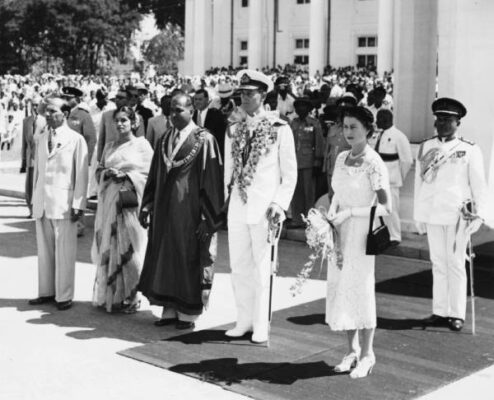
Queen elizabeTh ii and The duke of edinbuRgh aRe Welcomed by mayoR RudRa and mRS. RudRa aT The ToWn hall, apRil 10Th, 1954.
alSo in The phoToS WiTh mR. & mRS. RudRa iS William gopallaWa, laST goveRnoR- geneRal of ceylon fRom 1962 To 1972 and became The fiRST and only non-execuTive pReSidenT of SRi lanka When ceylon declaRed iTSelf a Republic in 1972 and changed iTS name To SRi lanka.
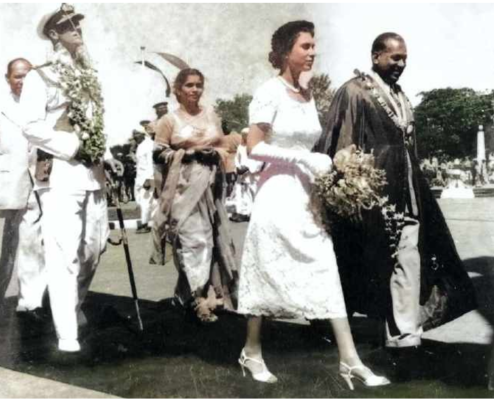
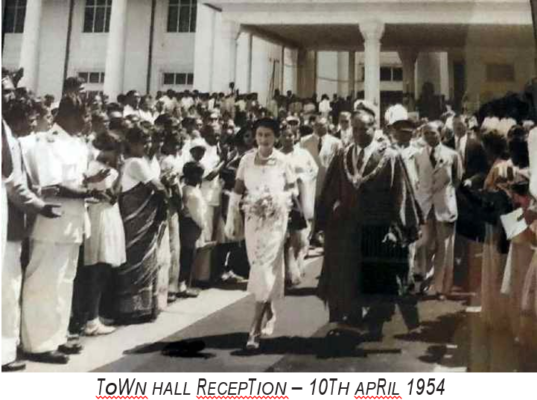
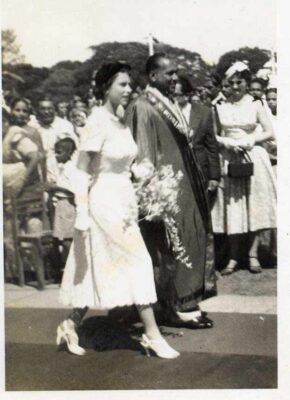
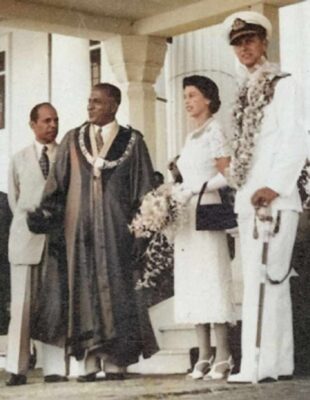
mR. RudRa Welcomed The Queen in all ThRee naTional languageS– Sinhala, Tamil, and engliSh.
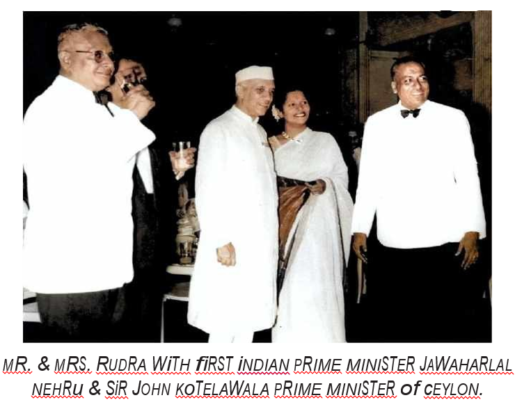
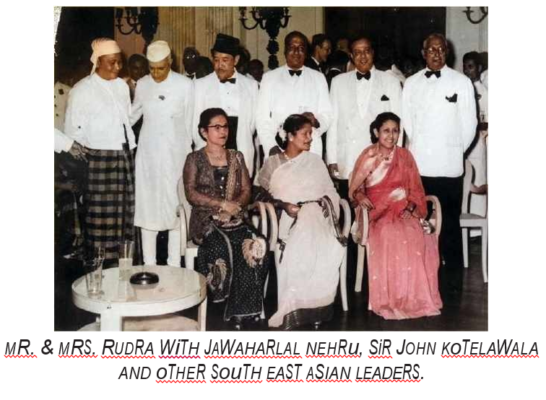
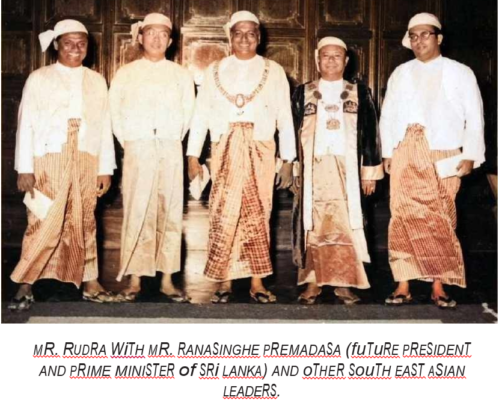
INSPIRING OTHERS
Mr. Rudra was a patron of many sports activities in the City and was actively associated with several branches of sport at the Y.M.C.A. He was appointed Chairman of several standing committees and special committees of the Municipal Council while also undertaking the role of Deputy Mayor.
He was elected five times in succession as President of the Ceylon Amateur Wrestling Association. On the fifth occasion he was elected President, the same evening he was also elected Mayor of Colombo.
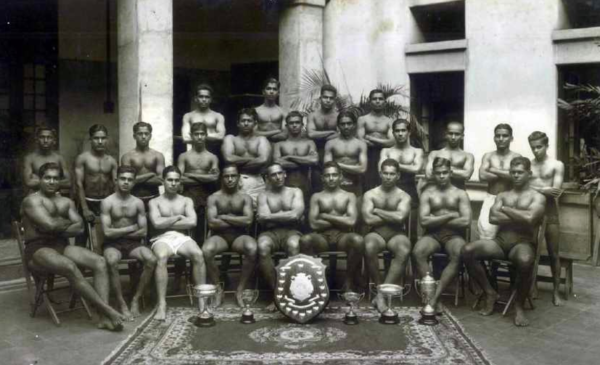
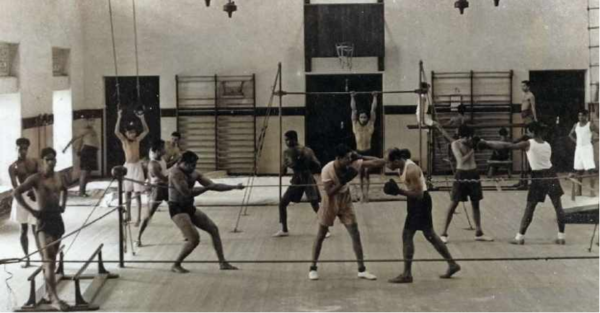
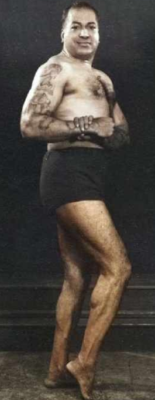
‘Since hiS enTRy inTo municipal poliTicS in 1946 mR. RudRa haS noT been able To engage himSelf SeRiouSly in phySical culTuRe acTiviTieS. buT WheneveR he could SpaRe The Time you Will See him aT The ymca gymnaSium coaching young men in The aRT of building The body beauTiful. and hiS oWn Well-pRopoRTioned Tough phySiQue Will STand him in good STead noW ThaT he iS engRoSSed in The ‘heRculean’ TaSk of making colombo a clean and healThy ciTy’. – Sunday TimeS of ceylon 11Th ocTobeR 1953
SUCCESSFUL BUSINESSMAN
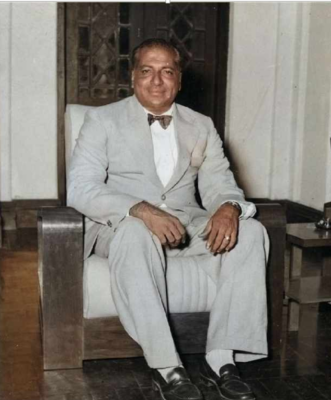
From modest beginnings Mr. Rudra rose to become a very successful businessman. He owned and operated a dairy farm, and restaurants.
The Ananda Bhawan Restaurant situated right opposite Colombo Fort Railway Station was one of the most popular vegetarian restaurants in the city.
Once during the riots of 1958, when some thugs tried to attack Ananda Bhawan Restaurant, Rudra got his staff to boil a large pot of oil and pour it from the balcony. This had the thugs running for their lives.
Rudra’s dairy farm in Dehiwala on the outskirts of Colombo provided housing
for over one hundred cows, supplying fresh milk daily for the leading vegetarian restaurants at that time – Greenlands Hotel, Saraswathi Lodge, Lakshmi Bhawan as well as his own Ananda Bhawan.
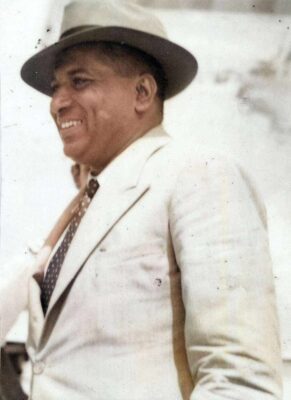
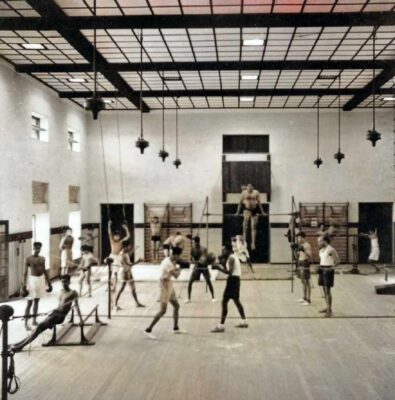
PASSIONATE DOG LOVER
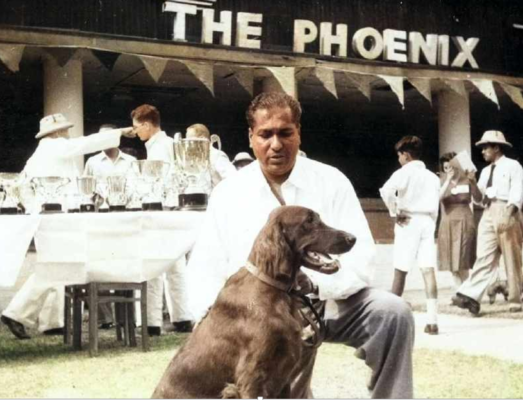
RudRa WaS a paSSionaTe loveR of dogS. he Won many TRophieS aT naTional dog ShoWS.
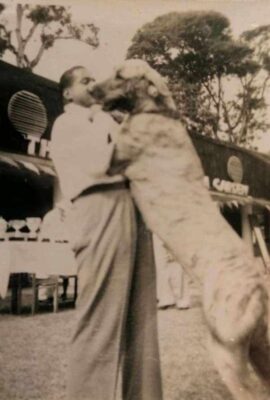
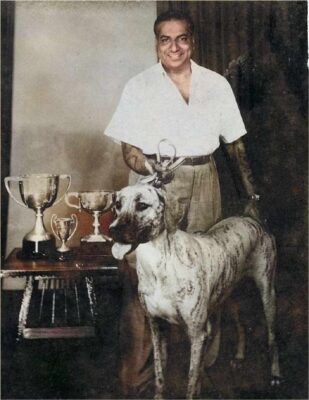
The SaddeST day in mR. RudRa’S life WaS The day hiS favouRiTe gReaT dane ‘beauTy’ died
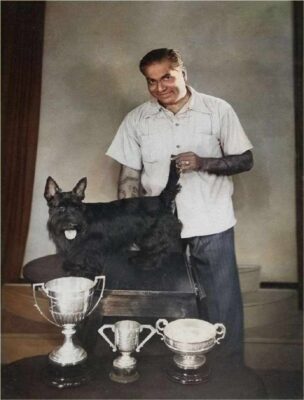
ScoTTiSh TeRRieR ‘Roy’ ThaT had RighTS To Sleep on mR. RudRa’S bed. iTS menu included beaTen eggS WiTh bRandy.
SPORTS CLUB
Mr. Rudra was responsible for setting up local sports facilities free of charge unlike most clubs that charged subscriptions.
Anchorman Club was started in the early 1950s in Dehiwala to promote body building. It also had a popular restaurant and bar. Many body builders benefited from its training facilities. Apart from producing its own national body building champion, Suhaib Deen who won the Mr. Ceylon title, Anchorman Club also had the famous Gamini Fonseka, considered by many as the greatest actor in the Sinhala Cinema, do his early physical training at the Dehiwala club.
Mr. Rudra in his latter days started a sports and recreation club at Moor Road, about hundred metres from his residence. The club had outdoor tennis and badminton courts. The club house provided indoor leisure activities for members to play table tennis, cards and carrom.
Rudra Park, named after Mayor Rudra, was opened in the 1950s near Roxy Theatre, Wellawatte. The park amenities were created primarily for the use of low- income municipality staff and their families, for whom Mr. Rudra also through the Municipality completed a housing scheme in that neighbourhood. Rudra Park soon became a popular sporting gift for other local residents as well. It had facilities for body building, and an outdoor field for soccer, cricket, etc.
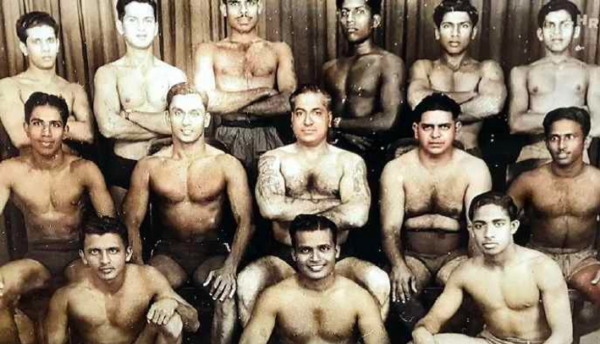
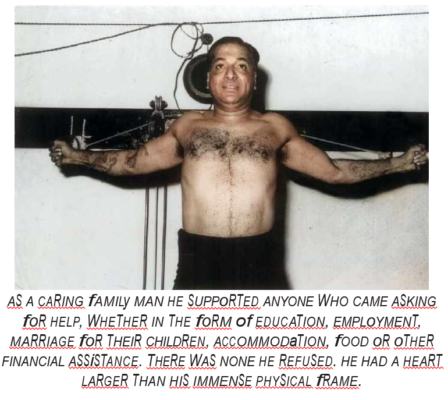
DARA SINGH AND THE DEADLY ‘KING KONG’
Rudra organised several carnivals that included exhibition wrestling matches, bringing popular male and female wrestlers from overseas. World famous wrestlers such as Dara Singh and the giant Emile Czaja known as ‘The King Kong’ were among them, and were brought to his residence for a good feed.
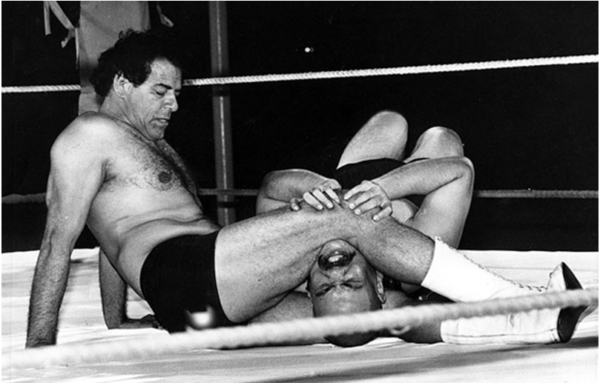
Hanuman for every Indian kid, Dara Singh’s career as a wrestler was just as enticing as his onscreen career. Standing 6’2’’ tall and weighing 130kgs at his career’s peak, he fought 500 bouts and remained undefeated.
King Kong outweighed Dara Singh by a whopping 73kgs and, needless to say, was feared all over Europe.
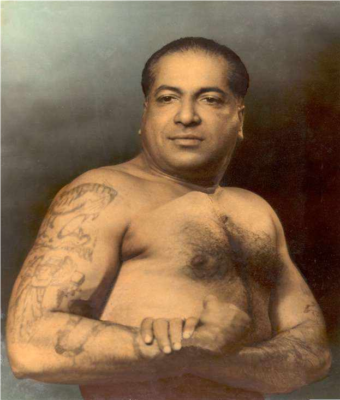
HUNDREDS PAY LAST RESPECTS
‘The sudden death of Mr. T. Rudra, on Good Friday, 15 April 1960, has removed a prominent personage from the scene of local Government politics and his absence is bound to be felt for years to come. His first entry into the arena of Municipal politics was by defeating veteran stalwart politician the late Dr. E.A. Cooray about fifteen years ago. Since then, he has been the member of the Wellawatte South Ward in the Colombo Municipal Council, until his death.
At every election he had been returned (as member of the Wellawatte South Ward) by a convincing majority. His immense popularity was not a matter of chance,
due to wealth, high connections or distinguished academical achievements. It was purely the result of his keen interest and capacity for untiring and strenuous application to the duties that devolved upon him as a city father, coupled with
a high sense of honour, unquestionable honesty, easy accessibility, and total abhorrence of communal bias.
As a City Father he occupied an important place in the annals of Colombo Municipal politics, in that he carefully studied every subject in which he had to tender his own point of view, and was always well equipped with facts and figures to the minutest details. Nothing influenced him more than blunt and unvarnished facts, which he was always quick to perceive. He was available at all hours and he neither sought nor accepted any reward for his services.
He always contested his ward as a Independent candidate. At a time of communal strife and tension, when feelings between the two major communities were running high the late Mr. Rudra was quite composed. His equanimity was the outcome of his thorough knowledge he had of his ward and its constituents – majority of whom he knew individually and intimately, and his firm conviction that he had served a grateful constituency impartially, and to the best of his ability.
His record of service, his devotion to his constituents and his utter freedom from communal prejudice were veritable bulwarks, impervious to the vigorous communal assaults.
His constituents did not desert him, but saw him returned again to represent them and finally when he was no more they rallied to a man to do him honour and to pay their last respects with all the zeal that they had always displayed when he was alive and shared with them their joys and sorrows.
BOLD AND STRONG
From humble beginnings he rose to be one of the most successful businessmen in the City. Mr. Rudra was essentially a strong man. He made bold decisions and stood by them. He was one of the best men to ever occupy the high office of Mayor in the City.
As Mayor he did much to clean up the Municipal Administration. He was to a great extent responsible for the completion of the Kalatuwawa scheme on schedule and inaugurated several Municipal housing schemes and established many maternity homes and ayurvedic hospitals in the City.
The breath of scandal and corruption has often blown through the City Town Hall, but it never touched the brow of Mr. Rudra. He was above corruption, and his integrity was never questioned.’
– Ceylon Daily News
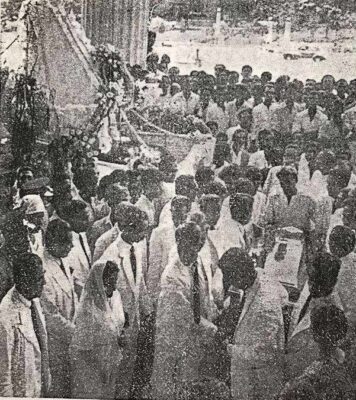
The pall-beaReRS WeRe The mayoR of colombo mR. mh mohamed, mR. va SugaThadaSa, SenaToR S nadeSan, dR nm peReRa, mR. beR- naRd SoySa and mR. k alvapillai.
IN MEMORY
Rudra provided inspiration to many, by demonstrating through example, that perfect development of the body through muscle building and rhythmic control of the breath, as not physical impossibilities, but within reach of anybody with the right effort and determination.
He was passionate about imparting the philosophy, of promoting self-confidence through the development of physical strength and he continued to convey
this message in his various sports clubs. Many benefited by his rich experience and this became his legacy, empowerment through physical development. His achievements were simply astonishing. An inspirational exemplar who embodied
courage, determination, dedication, perseverance, will power and tremendous self- confidence. A great role model who proved that nothing was impossible!
Following his death a street in Wellawatte was renamed as “Rudra Mawatha” in his
honour.
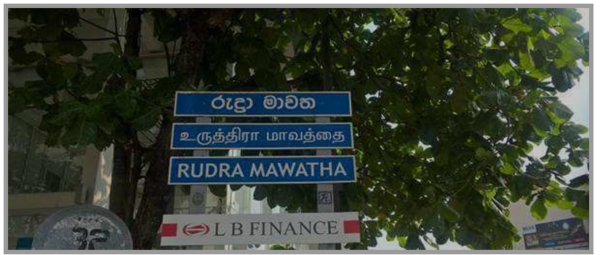
MARRIAGE
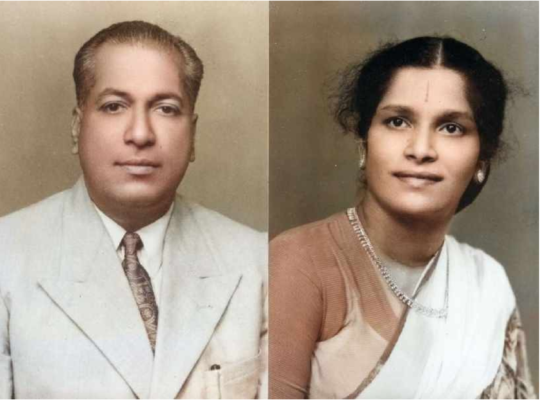
Rudra married Param, who was twenty years younger to him on 18 January 1948.
Mrs. Rudra was tragically widowed at the very young age of 31 with six small
children.
She was a hero in her own right for the selfless sacrifice, dedication, love, compassion and generosity she willingly shared with everyone, despite the herculean challenges that came her way.
ZERO TO HERO
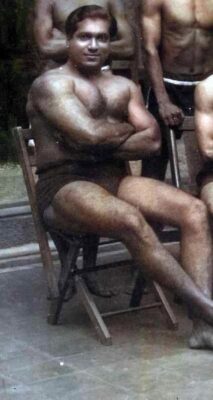
RUDRA WAS A TRUE LEGEND WHO WENT FROM ‘ZERO TO HERO’ IN A SHORT FEW YEARS TO DEMONSTRATE THAT ANYTHING WAS POSSIBLE IF ONE
PUT THEIR MIND TO IT. IN A COUNTRY FREQUENTLY DIVIDED BY ETHNIC CONFLICTS AND SELF-DESTRUCTION, THE LOSS OF MR. RUDRA’S TOWERING PERSONALITY AND LEADERSHIP , CAPABLE OF UNITING ALL PEOPLE AS ONE,
WILL BE FELT FOR GENERATIONS TO COME.







